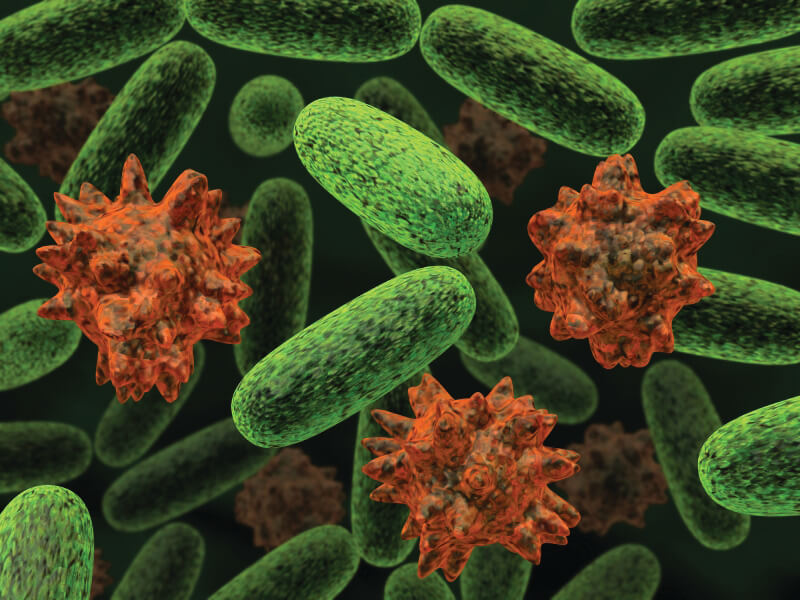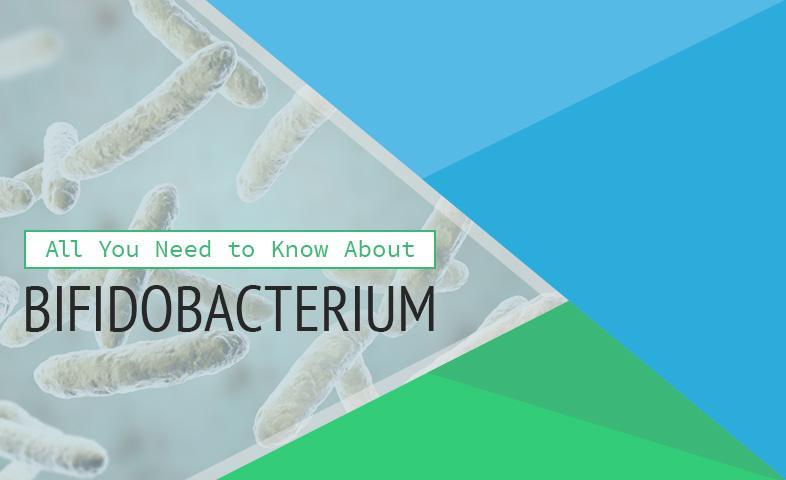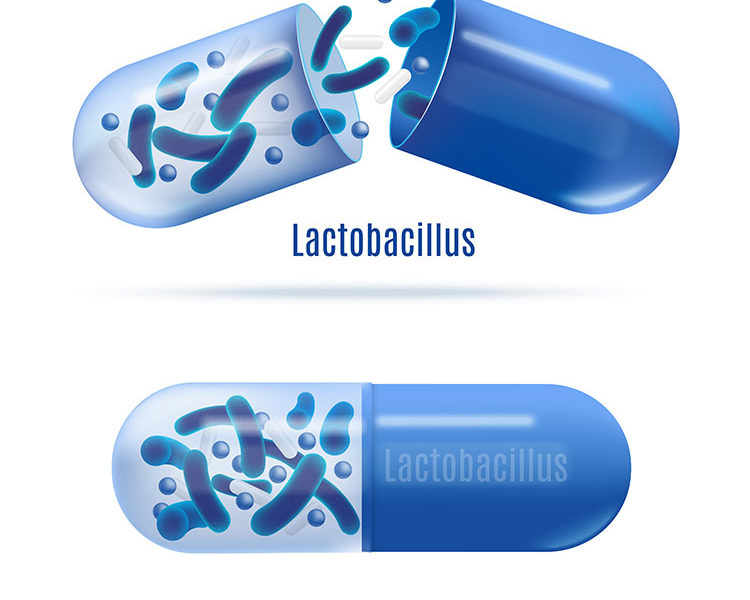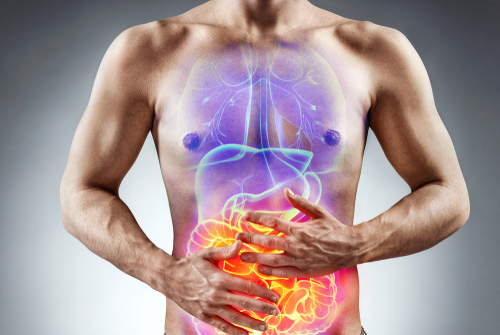
Probiotics & Their Multifold Benefits
Loosely defined, probiotics are ingested microbes that can modify intestinal microbial populations in a way that benefit the host. Many of the benefits of supplemental microflora, including Bifidobacteria and Lactobacilli, are well known. These benefits include maintenance of intestinal homeostasis, competitive exclusion of pathogens, production of antimicrobial compounds, promotion of the intestinal barrier function, immune modulation and some very promising results in the area of inflammatory bowel disease.1
There are more than 400 different species of microbes in the intestinal tract. These lactic acid-producing bacteria provide many benefits, including:
Synthesizing vitamins and increasing the bioavailability of minerals.5 Maintaining the mucosal barrier.6 Reduces untoward symptoms of Irritable Bowel Syndrome.7 Inhibiting bacterial pathogens by producing lactic acid, hydrogen peroxide and antibacterial substances called bacteriocins.8,9 Stimulating immune function,10,11,12 and modulating immune system hypersensitivity.13 Inhibiting Candida albicans.14
Probiotic bacteria colonize primarily the human colon15, produce lactic acid and work to block bacterial infection in the gut by producing antimicrobial substances that are effective against many harmful gram-positive and gram-negative bacteria.16,17 Further, many species of Lactobacilli and Bifidobacteria bind to the intestinal mucosa and prevent attachment of pathogenic coliform bacteria.18,19,20
Probiotics and the Immune System
It is important to note that intestinal immune tissue constitutes nearly 80% of all the immunologically active cells in the body. Research demonstrates an important relationship between microflora and the intestinal immune system. The most dramatic demonstration of the immune stimulating properties of probiotics is in studies on animals raised in a “germ-free” environment (gnotobiotic environment). In these animals, the intestinal immune system is underdeveloped, but is rapidly restored to a normal state upon the introduction of even a single bacterial species.21
Surprisingly, despite the presence of many potential pathogens in the intestinal microflora mix, humans rarely get infected. Research is beginning to clarify why. We now know that the intestine interacts with intestinal bacteria to develop several protective mechanisms. These include two major areas: (1) improving the intestinal barrier function, which is a combination of a mucus layer and the intestinal epithelial cells themselves and (2) stimulating immune function while avoiding exaggerated responses via immune modulation. This interaction between the human host and probiotic microflora is believed to explain some of the clinical benefits, such as treatment and prevention of diarrhea, reducing the risk of necrotizing enterocolitis and modulating host immune response (such as in allergic disease).22
In a study with healthy adult volunteers, immune response connected with supplemental Lactobacillus acidophilus and Bifidobacterium lactis was clearly demonstrated. L. acidophilus and B. lactis demonstrated significant cellular immune response indicated by increased phagocytic activity of granulocytes and monocytes. The activity of these white blood cells were significantly elevated from 92 to 95% during the probiotic phase of the study.23
Multiple organ dysfunction syndrome (MODS) is a major cause of mortality in intensive care units. Most often this results from an abdominal infection from mildly pathogenic organisms like coagulase-negative Staphylococcus, Enterococcus, and Candida species, among others. A breakdown in the intestinal barrier function and immune dysfunction is directly related to the onset of MODS. Probiotic bacteria have been shown to modulate intestinal barrier and immune function. In a recent study, ICU patients responded to probiotics with a significantly larger increase in systemic Immunoglobulins (IgA and IgG) concentrations than in the patients who did not receive probiotics. The authors’ conclusion: patients receiving probiotics show a greater enhancement in immune activity than patients who do not receive probiotics.24
The effect of Lactobacillus casei immunomodulatory activity on inflammation and coagulation during pneumococcal pneumonia was investigated. Supplemental L. casei accelerated the rate of recovery of defense mechanisms against pneumococci by inducing different cytokine profiles. These cytokines were involved in the improvement of the immune response and in the induction of a more efficient regulation of the inflammatory process, limiting the injury caused.25
Macrophages are an important cellular component of the immune system. They are active phagocytic cells and part of the reticuloendothelial system. They are an important part of the body’s antiviral response, actively destroying infected cells. Probiotics play an important role in supporting a balanced immune system in part by stimulating the phagocytic activity in macrophages. In a recent in vitro study, both Lactobacillus and Bifidobacteria species were able to decrease viral infections by stimulating an antiviral response in macrophages in cells infected with vesicular stomatitis virus (VSV).26
One of the most effective probiotic species is the spore-forming bacteria Lactobacillus sporogenes (also called Bacillus coagulans). The spore protects the bacteria in the acid environment of the stomach providing a much higher survival rate compared to non-spore forming bacteria. In the alkaline environment of the small intestine, the active, live bacteria emerge from the spore. Not only does it produce lactic acid, it has been shown to have significant antioxidant and free radical scavenging activity.27,28
There are still many questions about how probiotics modulate and stimulate the immune system. Yet, it is clear there is a very real response in support of the immune system by these friendly microflora. No doubt research will continue to elucidate the how and why of their actions. In the meantime, all of us can benefit from supplementation with probiotics, regardless of age or gender.
Probiotics and Allergic Disorders
Common allergy symptoms generally begin in infancy. It turns out that a baby’s immune response to the environment is generally more typical of allergic disease. Today, allergic disease is on the rise in developed countries and has led to the so called “hygiene hypothesis”29,30. In essence, this hypothesis bases the increase in allergic disease to increased hygiene, which reduces exposure to microbial stimuli. The result of this is rather than developing a tolerance to antigens, the tendency is for a greater allergic type response31,32. Research seems to demonstrate that colonization of friendly flora in the intestine of infants is an important factor in the development of a tolerance to environmental antigens, which in turn prevents or at least reduces allergic diseases in children. A 2001 study demonstrated a significant reduction in the frequency of atopic dermatitis when babies either received a Lactobacillus supplement or nursed with mothers that took thesupplement.33 The immunological basis for this phenomenon is yet to be determined. Still, it is apparent that probiotic supplementation has an important effect on intestinal immune system development in infants. Clinical trials have shown that symptoms of atopic eczema in infants can be significantly improved through the addition of Lactobacilli or Bifidobacterium species.34
Allergic disorders may be considered aberrant barrier functions of the skin and intestinal mucosa and the result of over stimulation of the immune response to environmental antigens. The current approach to treatment include strengthening the gut barrier function and modulation of abnormal immune responsiveness. Lactobacilli and/or Bifidobacteria aid in the degradation or modification of enteral antigens, regulation of inflammatory mediators and a modulation of an over-active immune response when the risk of allergic disease is heightened.35
Modulation of commensal bacteria of the gut with probiotics has been shown to moderate the immune system and to have an effect on both the prevention and treatment of food allergy.36
Early dietary intervention with oligosaccharide prebiotics has a protective effect against both allergic manifestations and infections. The observed dual protection lasting beyond the intervention period suggests that an immune modulating effect through the intestinal flora modification may be the principal mechanism of action.37,38
Probiotics and Genitourinary Candidiasis
World wide, yeast and bacterial vaginitis affect nearly a billion women annually. Currently, antibiotics are the main therapeutic agents used in treatment. Yet, recurrence of infection, side effects and secondary infections are common. The disruption of native vaginal bacteria, primarily lactobacilli, after antibiotic therapy, leaves the vagina susceptible to overgrowth of yeast as well as bacterial vaginosis. There is growing evidence from in vitro and human data to suggest that certain lactogenic bacteria may provide health benefits for a large number of women.39
While antibiotic therapy is generally effective at treating the initial infection, the repeated use of these antimicrobial agents upon recurrence contributes to an increasing development of microbial resistance. It is clear that intestinal and urogenital microflora play a central role in maintaining the health and well-being of humans. Therefore, the use of supplemental probiotics to replace or augment natural bacterial populations is gradually achieving acceptance.40,41
Lactobacilli have long been considered the protective flora in the vagina that displace and kill vaginal pathogens. Lactic acid, H2O2, and antibacterial agents called bacteriocins are believed to be the source of the anti-bacterial and anti-candidal activity of lactogenic bacteria. Two of the identified bacteriocins are lactocin and bacitracin, though there are others. A study with Lactobacillus sporogenes was shown to be effective in a variety of vaginal diseases. The organisms were viable and exhibited the production of lactic acid, hydrogen peroxide and demonstrated antagonistic activity against the uropathogens.42
In vitro studies have shown that lactobacilli can inhibit the growth of Candida albicans and/or its adherence on the vaginal epithelium. The results of a clinical trial support the effectiveness of lactobacilli, especially Lactobacillus acidophilus and Lactobacillus rhamnosus, administered either orally or intravaginally in colonizing the vagina and/or preventing the colonization and infection of the vagina by Candida albicans.43
The question arises as to what actually produces the anti-yeast activity in lactogenic bacteria. A study was conducted comparing the anti-candidal activity of live active cultures of various Lactobacillus strains against the actual chemical compounds of pure H2O2 and lactic acid. Interestingly, the cultures demonstrated significantly greater activity than the pure chemical compounds. This supports the concept that mixtures of Lactobacillus strains provide many different metabolites and that there are other factors beyond hydrogen peroxide and lactic acid producing anti-candidal activity. No doubt the bacteriocins and possibly other factors contribute to the anti-candidal activity of the Lactobacillus strains.44
Lactobacillus strains with known antagonistic properties against bacteria were tested for their adhesion to vaginal cell lines in vitro and their antagonistic activities against Candida. Their anti-candidal activity was related to hydrogen peroxide (H2O2) production in some strains, but even in the presence of catalase treatment that suppress H2O2, anti-candidal activity continued, suggesting alternative mechanisms.45
Another in vitro study with the probiotic Lactobacillus plantarum investigates whether this organism had any effects upon the Candida populations. Although C. albicans was not completely eradicated in the presence of this bacterium, cell counts were markedly reduced, indicating a compromised physiological function. This study shows that normal gut flora can exert limiting effect on C. albicans. Unfortunately, this effect appears to be diminished during antibiotic intake. The authors conclude the use of probiotics can help fortify natural resistance.46
There are numerous studies demonstrating the direct application of Lactobacillus directly into the vaginal canal to both suppress C. albicans and to maintain normal balance of microflora.47,48,49 Still, there is substantial evidence to support the case for oral lactogenic bacteria to accomplish the same. What does seem to be clear from the literature is that a combination of different lactogenic bacterial will provide the greatest results. This is due to the fact that not all lactogenic bacteria produce H2O2, though most do. It is clear that other properties contribute to the over all anti-candidal activity, including lactic acid and a variety of bacteriocins as well as other currently unknown factors.
Diarrhea
There are many citations of the resolution of diarrhea utilizing probiotics. This is well known. A more interesting issue is whether probiotics can prevent diarrhea while taking antibiotics. Previously, It was commonly thought Lactobacilli and Bifidobacteria supplements were not effective if taken during antibiotic therapy. Recent research supports the use of probiotics during antibiotic administration.50,51 In fact, L. acidophilus has been shown to correct the increase of gram-negative bacteria that commonly occurs following the use of broad-spectrum antibiotics given when treating acute or chronic diarrhea.52,53,54 Furthermore, reductions of friendly bacteria and/or advanced infection with antibiotic-resistant bacteria may be prevented by using L. acidophilus and antibiotics concurrently (a dosage of 15 to 20 billion probiotic organisms is recommended).55
Inhibition of Pathogenic Bacteria
A double blind study examining the effect of L. acidophilus and L. casei on small intestinal bacterial overgrowth, researchers found a significant decrease as early as one week into treatment.56 At least part of the action is believed to be the result of substances produced by probiotics called bacteriocins. These compounds act as natural antibiotics to kill undesirable microorganisms.57
Additional Lactobacillus species include L. brevis, which may increase the production of IFN-alpha;58 L. bulgaricus, which helps reduce cholesterol levels59,60 and can inhibit the growth of H. pylori;61 and L. plantarum, which can reduce the severity of chemotherapy-induced enterocolitis62 and inhibit attachment of E. coli bacterium to human colon cells.63
Irritable Bowel Syndrome and Other GI Disorders
Recent research in Irritable Bowel Syndrome has proven to be very positive. Lactobacillus. plantarum has been shown to reduce abdominal pain and flatulence in patients with irritable bowel syndrome (IBS) and may help prevent traveler’s diarrhea.64,65 Lactobacillus casei has also shown very positive results in IBS.1
The Bifidobacteria also offer a host of benefits, particularly with GI diseases and diarrhea. When used as an adjunct to treatment with medication, a combination of B. brevis, B. bifidum and L. acidophilus was shown to help prevent relapse and reduce symptoms in patients with ulcerative colitis.66,67 And some research indicates that taking B. longum can reduce stool frequency, abdominal discomfort, and stool clostridial spore count in antibiotic-associated diarrhea;68
Effective Supplementation
Oral supplementation of common Lactobacilli and Bifidobacteria species have a good safety profile and are well tolerated, as evidenced throughout studies in which they were used up to one year and longer. There are no known drug interactions with these probiotic species.69,70
For additional health benefits, probiotic products are best when combined with “prebiotics,” such as fructooligosaccharides (FOS), galactooligosaccharides and inulin. When probiotics are combined with prebiotics, the resulting supplement is called a synbiotic. Prebiotics promote the growth and activity of probiotic bacteria.71,72,73 FOS particularly may even help relieve constipation by increasing fecal mass.67
Clearly, given the many benefits of the various probiotic species, it makes perfect sense to provide a comprehensive blend of many different species that will then provide the best attributes of each in a single probiotic supplement. In terms of daily dosage, at least 10 billion colony forming units (CFU) is recommended,74 although 14 to 20 billion CFU may be more desirable.
References
- Sheil, B., et al., “Probiotic effects on inflammatory bowel disease.” J Nutr, 137(3 Suppl 2): 819S-24S 2007
- Madsen K, et al. “Lactobacilli prevents colitis in interleukin 10 gene-deficient mice.” Gastroenterol. 1999;116:1107-14.
- Shornikova AV et al. “Lactobacillus reuteri as a therapeutic agent in acute diarrhea in young children.” J Pediatr Gastroenterol Nutr. 1997;24:399-404.
- Zeng J, et al. Clinical trial: effect of active lactic acid bacteria on mucosal barrier function in patients with diarrhoea-predominant irritable bowel syndrome. Aliment Pharmacol Ther, 28(8): 994-1002 2008.
- Velraeds MM et al. “Inhibition of initial adhesion of uropathogenic Enterococcus faecalis by biosurfactants from Lactobacillus isolates.” Appl Environ Microbiol. 1996;62:1958-63.
- Gupta K et al. “Inverse association of H2O2-producing Lactobacilli and vaginal Escherichia coli colonization in women with recurrent urinary tract infections.” J Infect Dis. 1998;178:446-50.
- Schultz M, Sartor RB. “Probiotics and inflammatory bowel diseases.” Am J Gastroenterol. 2000;95:S19-21.
- deRoos NM, Katan MB. “Effects of probiotic bacteria on diarrhea, lipid metabolism, and carcinogenesis: a review of papers published between 1988 and 1998.” Am J Clin Nutr. 2000;71:405-11.
- Isolauri E et al. “Probiotics: effects on immunity.” Am J Clin Nutr. 2001;73:444S-450S.
- Pelto L et al. “Probiotic bacteria down-regulate the milk-induced inflammatory response in milk-hypersensitive subjects but have an immunostimulatory effect in healthy subjects.” Clin Exp Allergy. 1998;28:1474-9.
- Wagner RD et al. “Biotherapeutic effects of probiotic bacteria on candidiasis in immunodeficient mice.” Infect Immunol. 1997;65:4165-4172.
- Macfarlane GT, Cummings JH. “Probiotics and prebiotics: can regulating the activities of intestinal bacteria benefit health?” BMJ. 1999;318:999-1003.
- Lievin V et al. “Bifidobacterium strains from resident infant human gastrointestinal microflora exert antimicrobial activity.” Gut. 2000;47:646-52.
- Rastall RA. “Bacteria in the gut: friends and foes and how to alter the balance.” J Nutr. 2004;134:2022S-2026S.
- Chen RM et al. “Increase of intestinal Bifidobacterium and suppression of coliform bacteria with short-term yogurt ingestion.” J Dairy Sci. 1999:82:2308-14.
- Chiang BL et al. “Enhancing immunity by dietary consumption of a probiotic lactic acid bacterium (Bifidobacterium lactis HN019): optimization and definition of cellular immune responses.” Eur J Clin Nutr. 2000;54:849-55.
- Lewis SJ, Freedman AR. “Review article: the use of biotherapeutic agents in the prevention and treatment of gastrointestinal disease.” Aliment Pharmacol Ther. 1998;12:807-22.
- McCracken VJ, Gaskins HR (1999) In Probiotics: a Critical Review. (ed. GW Tannock),
- Saavedra, JM, “Use of probiotics in pediatrics: rationale, mechanisms of action, and practical aspects.” Nutr Clin Pract, 22(3): 351-65 2007
- Klein, A., et al., “Lactobacillus acidophilus 74-2 and Bifidobacterium animalis subsp lactis DGCC 420 modulate unspecific cellular immune response in healthy adults.” European Journal of Clinical Nutrition 2007; 10:1038
- Alberda, C., et al., “Effects of probiotic therapy in critically ill patients: a randomized, double-blind, placebo-controlled trial.” Am J Clin Nutr, 85(3): 816-23 2007
- Agañero, G. et al., Beneficial immunomodulatory activity of Lactobacillus casei in malnourished mice pneumonia: effect on inflammation and coagulation. Nutrition, 22(7-8): 810-9 2006
- Ivec, M. et al., Interactions of macrophages with probiotic bacteria lead to increased antiviral response against vesicular stomatitis virus. Antiviral Res, (): 0 2007
- Kodali, V., Sen, R. Antioxidant and free radical scavenging activities of an exopolysaccharide from a probiotic bacterium. Biotechnol J 2008
-
- Kale VV, et al. Development and evaluation of a suppository formulation containing Lactobacillus and its application in vaginal diseases. Ann N Y Acad Sci, 1056(): 359-65 2005
- Prescott SL, Macaubas C, Holt BJ, Smallacombe TB, Loh R, Sly PD, et al., “Transplacental priming of the human immune system to environmental allergens: universal skewing of initial T cell responses toward the Th2 cytokine profile.” (1998) J Immunol 160:4730-4737.
- Prescott SL, Macaubas C, Smallacombe TB, Holt BJ, Sly PD, Holt PG, “Development of allergen-specific T-cell memory in atopic and normal children.” (1999) Lancet 353:196-200.
- Erb KJ “Atopic disorders: a default pathway in the absence of infection?” (1999) Immunol Today 20:317-22.
- Matricardi PM, Bonini S, “High microbial turnover rate preventing atopy: a solution to inconsistencies impinging on the Hygiene hypothesis?” (2000) Clin Exp Allergy 30:1506-10.
- Kalliomäki M, Salminen S, Arvilommi H, Kero P, Koskinen P, Isolauri E, et al., “Probiotics in primary prevention of atopic disease: a randomised placebo-controlled trial.” (2001) Lancet 357:1076-79.
- Ouwehand, A.C., et al., “Antiallergic effects of probiotics.” J Nutr, 137(3 Suppl 2): 794S-7S 2007
- Isolauri E, Salminen s. Probiotics: use in allergic disorders: a Nutrition, Allergy, Mucosal Immunology, and Intestinal Microbiota (NAMI) Research Group Report. J Clin Gastroenterol, 42 Suppl 2(): S91-6 2008
- Savalahti E, et al. Pre and probiotics in the prevention and treatment of food allergy. Curr Opin Allergy Clin Immunol, 8(3): 243-8 2008
- Arslanoglu S, et al. Early dietary intervention with a mixture of prebiotic oligosaccharides reduces the incidence of allergic manifestations and infections during the first two years of life. J Nutr, 138(6): 1091-5 2008
- Lorente F, et al. Prevention of allergic diseases. Allergol Immunopathol (Madr), 35(4): 151-6 2007
- Reid, G. Probiotics for Urogenital Health. Nutr Clin Care, 5(1): 3-8 2002
- Morelli, L., et al. Utilization of the intestinal tract as a delivery system for urogenital probiotics. Clin Gastroenterol, 38(6 Suppl): S107-10 2004
- Reid, G., et al. Oral probiotics can resolve urogenital infections. FEMS Immunol Med Microbiol, 30(1): 49-52 2001
- Kale VV, et al. Development and evaluation of a suppository formulation containing Lactobacillus and its application in vaginal diseases. Ann N Y Acad Sci, 1056(): 359-65 2005
- Falagas, ME, et al. Probiotics for prevention of recurrent vulvovaginal candidiasis: a review. J Antimicrob Chemother, 58(2): 266-72 2006
- Strus, M., et al. Inhibitory activity of vaginal Lactobacillus bacteria on yeasts causing vulvovaginal candidiasis. Med Dosw Mikrobiol, 57(1): 7-17 2005
- Strus, M., et al. The in vitro activity of vaginal Lactobacillus with probiotic properties against Candida. Infect Dis Obstet Gynecol, 13(2): 69-75 2005
- Payne, s., Gibson, G., et al. In vitro studies on colonization resistance of the human gut microbiota to Candida albicans and the effects of tetracycline and Lactobacillus plantarum LPK. Curr Issues Intest Microbiol, 4(1): 1-8 2003
- Okkers DJ , et al. Characterization of pentocin TV35b, a bacteriocin-like peptide isolated from Lactobacillus pentosus with a fungistatic effect on Candida albicans. J Appl Microbiol, 87(5): 726-34 1999
- Parent D, Bossens M, Bayot D, et al. Therapy of vaginosis using exogenously-applied lactobacilli acidophili and a low dose of estriol: A placebo-controlled multicentric clinical trial. Arzneimittel Forschung 1996; 46(1):68-73.
- Williams AB, Yu C, Tashima K, et al. Evaluation of two self-care treatments for prevention of vaginal candidiasis in women with HIV. J Assoc Nurses AIDS care 2001; 12(4):51-57.
- Zoppi G et al. “Oral bacteriotherapy in clinical practice. I. The use of different preparations in infants treated with antibiotics.” Eur J Ped. 1982;139:18-21.
- Gotz VP, Romankiewics JA, Moss J. “Prophylaxis against ampicillin-associated diarrhea with a lactobacillus preparation.” Am J Hosp Pharm. 1979;36:754-757.
- Hentges DJ, ed. Human intestinal microflora in health and disease. New York: Academic Press, 1983.
- Shahani KM, Ayebo AD. “Role of dietary lactobacilli in gastrointestinal microecology.” Am J Clin Nutr. 1980;33:2448-2457.
- Friend BA, Shahani KM. “Nutritional and therapeutic aspects of lactobacilli.” J Appl Nutr. 1984;36:125-152.
- Pizzorno JE, Murray MT. Textbook of Natural Medicine, 3rd edition. Churchill Livingstone; 2005.
- Gaon D et al. “Effect of Lactobacillus strains (L. casei and L. acidophilus strains cereal) on bacterial overgrowth-related chronic diarrhea.” Medicina (Brazil). 2002;62:159-163.
- Barefoot SF, Klaenhammer TR. “Detection and activity of Lactacin B, a Bacteriocin produced by Lactobacillus acidophilus.” Appl Environ Microbiol. 1983;45:1808–15.
- Kishi A et al. “Effect of the oral administration of Lactobacillus brevis subsp. coagulans on interferon-alpha producing capacity in humans.” J Am Coll Nutr. 1996;15:408-12.
- Doncheva NI et al. “Experimental and clinical study on the hypolipidemic and antisclerotic effect of Lactobacillus bulgaricus strain GB N 1 (48).” Nutr Res. 2002;22:393-403.
- Losada MA, Olleros T. “Towards a healthier diet for the colon: the influence of fructooligosaccharides and lactobacilli on intestinal health.” Nutr Res. 2002;22:71-84.
- Rasic J, Jovanovic D, Mira AC. Op cit.
- Wagner RD et al. Op cit.
- Mack DR et al. “Probiotics inhibit enteropathogenic E. coli adherence in vitro by inducing intestinal mucin gene expression.” Am J Physiol. 1999;276:G941-G950.
- Nobaek S et al. “Alteration of intestinal microflora is associated with reduction in abdominal bloating and pain in patients with irritable bowel syndrome.” Am J Gastroenterol. 2000;95:1231-8.
- O’Mahony L et al. “Lactobacillus and bifidobacterium in irritable bowel syndrome: symptom responses and relationship to cytokine profiles.” Gastroenterol. 2005;128:541-51.
- Ishikawa H et al. “Randomized controlled trial of the effect of bifidobacteria-fermented milk on ulcerative colitis.” J Am Coll Nutr. 2003;22:56-63.
- Kato K et al. “Randomized placebo-controlled trial assessing the effect of bifidobacteria-fermented milk on active ulcerative colitis.” Aliment Pharmacol Ther. 2004;20:1133-41.
- Colombel JF et al. “Yoghurt with Bifidobacterium longum reduces erythromycin-induced gastrointestinal effects.” Lancet. 1987;2:43.
- Lactobacillus monograph. Natural Medicines Comprehensive Database. Stockton, CA.
- Bifidobacteria monograph. Natural Medicines Comprehensive Database. Stockton, CA.
- Bouhnik Y et al. “Short-chain fructo-oligosaccharide administration dose-dependently increases fecal bifidobacteria in healthy humans.” J Nutr. 1999;129:113-6.
- Menne E, Guggenbuhl N, Roberfroid M. “Fn-type chicory inulin hydrolysate has a prebiotic effect in humans.” J Nutr. 2000;130:1197-9.
- Cummings JH, Macfarlane GT, Englyst HN. “Prebiotic digestion and fermentation.” Am J Clin Nutr. 2001;73:415S-420S.
- Catanzaro JA, Green L. “Microbial Ecology and Probiotics in Human Medicine (Part II).” Alt Med Rev. 1997;2(4):296-305.




